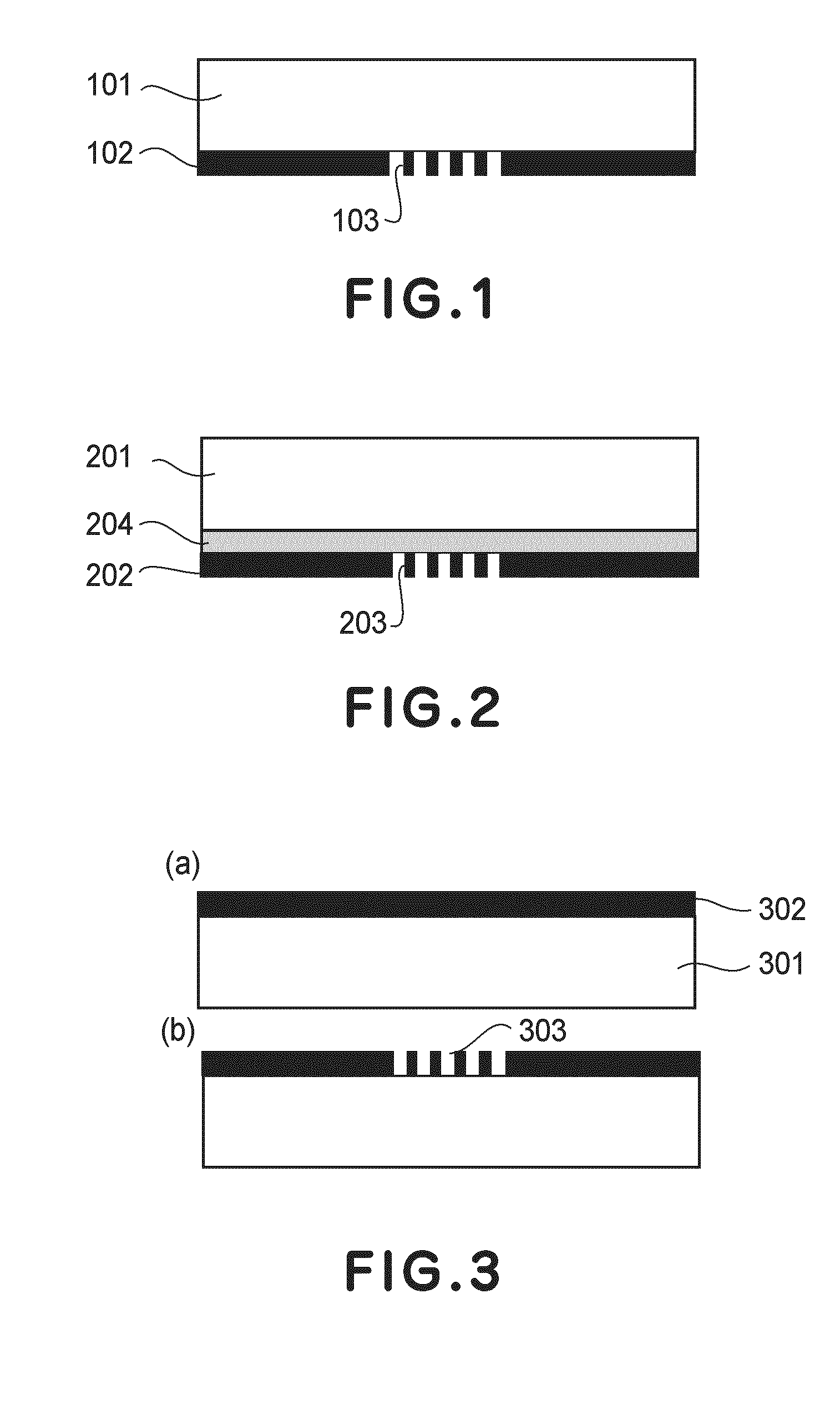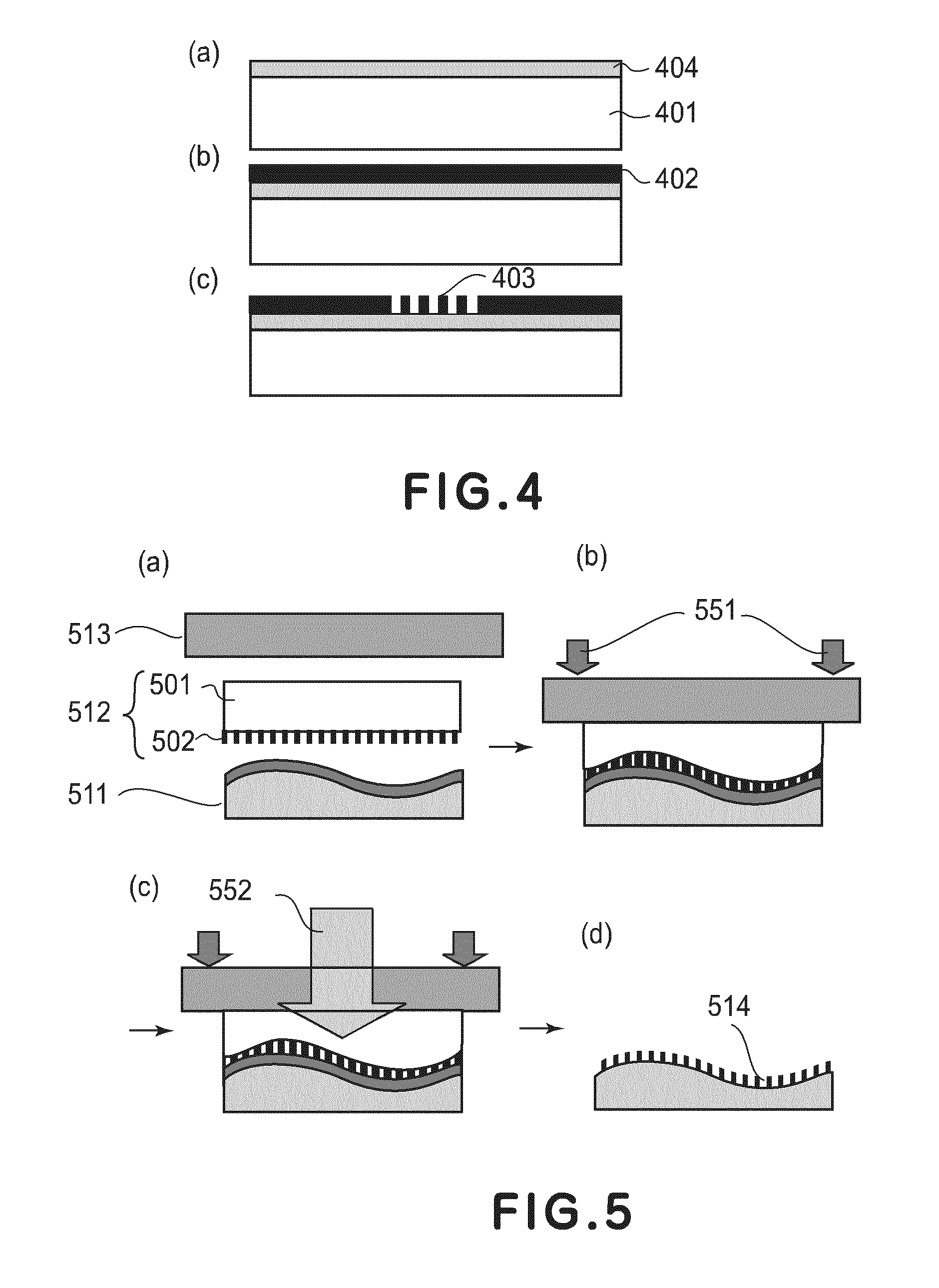Near-field exposure mask, near-field exposure apparatus, and near-field exposure method
a technology of near-field exposure and exposure apparatus, which is applied in the direction of photo-taking processes, printers, instruments, etc., can solve the problems of increasing the size of the exposure apparatus, the cost of the corresponding resist, the cost of the apparatus, etc., and achieves the effect of simple mechanism
- Summary
- Abstract
- Description
- Claims
- Application Information
AI Technical Summary
Benefits of technology
Problems solved by technology
Method used
Image
Examples
embodiment 1
[0070]A production process of a near-field exposure mask and the near-field exposure mask produced through the production process will be described.
[0071]FIGS. 3(a) and 3(b) are schematic views for illustrating the production process of the near-field exposure mask in this embodiment.
[0072]In this embodiment, first, on a mask base material 301, a light blocking film 302 is formed in a film by using a synthetic resin material which is transparent to exposure light and has a Young's modulus in a range of 1 GPa or more and 10 GPa or less as described in the above mentioned embodiment (FIG. 3(a)). The film formation is performed by sputtering, electron beam deposition, resistance heating deposition, chemical vapor deposition, or the like.
[0073]Then, a minute (fine) pattern 303 is formed with respect to the light blocking film 302 (FIG. 3(B)).
[0074]The patterning of the pattern 303 is performed by etching using, as a mask, a resist subjected to direct processing using a focused ion beam ...
embodiment 2
[0082]A production process of a near-field exposure mask including an intermediate layer and the near-field exposure mask produced through the production process will be described.
[0083]FIGS. 4(a), 4(b) and 4(c) are schematic views for illustrating the production process of the near-field exposure mask including the intermediate layer.
[0084]A mask base material 401, film formation of a light blocking film 402, and formation of a minute pattern 403 are similar to those in Embodiment 1, so that description thereof will be omitted.
[0085]In this embodiment, on the mask base material 401, an intermediate layer 404 is formed in a film (FIG. 4(a)).
[0086]In the case where SiO2 or SiN is employed as a material for the intermediate layer, the film formation is performed by sputtering, electron beam deposition, resistance heating deposition, chemical vapor deposition, or the like.
[0087]In the case where spin-on glass is used as the material for the intermediate layer, the film formation is per...
embodiment 3
[0089]A near-field exposure method using a near-field exposure mask according to the present invention will be described.
[0090]FIGS. 5(a) to 5(d) are schematic views for illustrating the near-field exposure method of this embodiment.
[0091]On a mask base material 501 side of a near-field exposure mask 512, a quartz glass 513 as a rigid member transparent to exposure light is provided and on a light blocking film 502 side of the near-field exposure mask 512, a resist-coated substrate to be exposed 511 is provided (FIG. 5(a)). The transparent rigid member is, however, not limited to the quartz glass 513. In this embodiment, the quartz glass 513 functions as an exposure mask supporting mechanism.
[0092]The resist is usable in this embodiment irrespective of the type thereof such as a positive type or a negative type so long as the resist has photosensitivity with respect to light from a light source. Examples of the positive resist may include diazonaphthoquinone-novolac resist and a che...
PUM
| Property | Measurement | Unit |
|---|---|---|
| Young's modulus | aaaaa | aaaaa |
| wavelength | aaaaa | aaaaa |
| Young's modulus | aaaaa | aaaaa |
Abstract
Description
Claims
Application Information
 Login to View More
Login to View More - R&D
- Intellectual Property
- Life Sciences
- Materials
- Tech Scout
- Unparalleled Data Quality
- Higher Quality Content
- 60% Fewer Hallucinations
Browse by: Latest US Patents, China's latest patents, Technical Efficacy Thesaurus, Application Domain, Technology Topic, Popular Technical Reports.
© 2025 PatSnap. All rights reserved.Legal|Privacy policy|Modern Slavery Act Transparency Statement|Sitemap|About US| Contact US: help@patsnap.com



